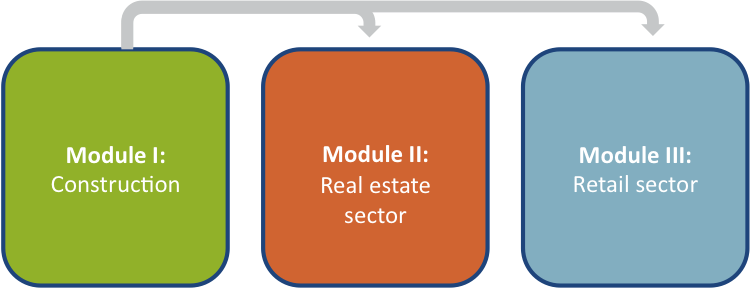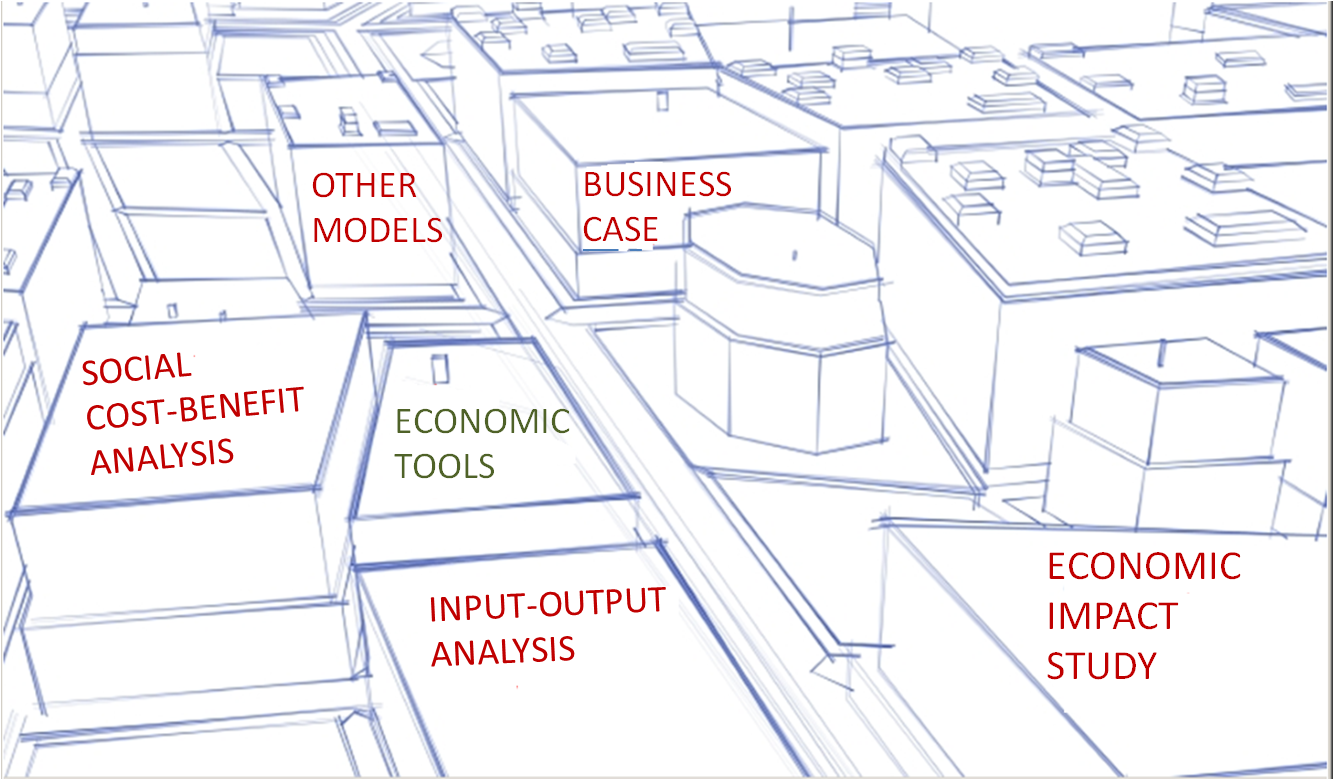Difference between revisions of "Economic Impact Study"
| Line 36: | Line 36: | ||
[[File:EIS_modules_V01.png|400px|Source: Decisio (2012)]] |
[[File:EIS_modules_V01.png|400px|Source: Decisio (2012)]] |
||
| + | ====Step 2: measuring the indirect and induced impact==== |
||
| + | The next step for economists is to estimate the indirect economic effects on the economy. These secondary impacts are more difficult to quantify and there are different approaches possible to do this. In case enough economic data/statistics are available, economists could use an [[Input-output analysis|input-output model]] to estimate the indirect effects. |
||
| + | {| class="wikitable" |
||
| − | |||
| + | |- |
||
| − | |||
| + | | An '''input-output model''' is a quantitative economic tool that captures the intersectoral transactions. It contains large tables of data that describe the transactions in pre-defined impact areas. These tables help the users to track the flow of money from one sector to the next. The technique of input-output analysis is originally created by Wassily Leontief (1965). |
||
| − | |||
| + | |} |
||
Revision as of 16:27, 23 May 2012
Contents
Economic Impact Study
An economic impact study (assessment or analysis) traces the total economic activity generated by a policy, investment, project, venue or activity in a pre-defined impact area. This impact area is determined by the nature of the explored case study and can enhance an individual city, region or an entire country. Economic impact studies support the decision making process to understand the economic consequences of all kinds of relevant questions such as:
- How much income does a spatial development project generate for city X?
- What portion of sales by local business is due to sector Y?
- How many jobs in region Z are supported by the construction sector?
- How much tax revenues will project 1 generate?
- How much income do households and businesses generate in area 2?
- What will the permanent and temporary economic effects be of project 3?
The wide scope of the above mentioned questions already suggests that economic impact studies are one of the most often applied economic tools to facilitate the preparation of a robust urban plan. One should keep in mind, however, that economic impact studies do not include the environmental and broader social impacts such as quality of life. Hence, impact studies are only one of the tools available for decision makers.
Measured economic effects
The economic impact model calculates the direct (primary), indirect and induced (secondary) effects of the urban development plan:
- Direct effects are production changes associated with the immediate effects of change in expenditures. An impulse in construction activity, for example, leads to an increase in wages, profits, taxes paid etc.
- Indirect effects are the production changes resulting from various rounds of re-spending of the receivers of the direct spending impulse in other backward-linked sectors. Architects and brick suppliers, for example, will receive orders from the construction companies responsible for the construction of the ordered development.
- Induced effects are the effects resulting from the re-expenditures of households. Employees of companies earn wages that are spend on goods and services. This means that not only the purchases of the construction companies are included, but also the expenses of the employees of the construction companies etc.
The model behind the economic impact study
There are multiple ways to perform an economic impact study, but in general, economists use models that exist of the following steps:
Step 1: measuring the direct impact
The direct impact of a spatial development contains the created direct expenditures and are associated with the first round of spending in the economy (without any subsequent transactions).
An example:
| The building of a new shopping mall will create temporarily jobs in the construction sector and permanent jobs in retail and affiliate sectors such as cleaning and maintenance. In addition, the real estate owners will generate income from lease contracts and the local government will be able to collect tax revenues. |
Based on the scope of the economic impact study, economists will focus their effort on those sectors in the pre-defined impact area that are affected most by the studies entity. For the example above, for instance, economists would focus their attention on the construction sector, the real estate sector and the retail sector. To do this, some economists create different modules in order to determine the interrelations between the different sectors (see example below):
Step 2: measuring the indirect and induced impact
The next step for economists is to estimate the indirect economic effects on the economy. These secondary impacts are more difficult to quantify and there are different approaches possible to do this. In case enough economic data/statistics are available, economists could use an input-output model to estimate the indirect effects.
| An input-output model is a quantitative economic tool that captures the intersectoral transactions. It contains large tables of data that describe the transactions in pre-defined impact areas. These tables help the users to track the flow of money from one sector to the next. The technique of input-output analysis is originally created by Wassily Leontief (1965). |
In order to measure the economic impact of an urban project development, economists use several modules (depending on the project scope).
The example on the right hand side contains three modules:
- construction,
- residential, and
- tourism.
The main input for the modules is determined by the scope of the project (the amount of residential units, hotel rooms, bars and restaurant etc.). Based on the input and its interrelationships, the module calculates the direct output impacts of the development plan.
The economic impact model calculates the direct (primary), indirect and induced (secondary) effects of the urban development plan:
- Direct effects are production changes associated with the immediate effects of change in expenditures. An impulse in construction activity, for example, leads to an increase in wages, profits, taxes paid, et cetera.
- Indirect effects are the production changes resulting from various rounds of re-spending of the receivers of the direct spending impulse in other backward-linked industries. Architects and brick suppliers, for example, will receive orders from the construction companies responsible for the construction of the ordered development.
- Induced effects are the effects resulting from the re-expenditures of households. Employees of companies earn wages that are spend on goods and services. This means that not only the purchases of the construction companies are included, but also the expenses of the employees of the construction companies et cetera.
Model calculations
Based on the direct input (the amount of invested capital and labour, etc.), economists calculate the impact of the urban development project on the whole economy. This is mostly done with the help of so-called input-output analyses.
Data collection and analyses
The data and information used by model engineers are mostly available from existing data or previous studies. The following list sums up some of the information needed:
| Supply information | Demand information |
|---|---|
| Demographic statistics (resident population, employment statistics, number and type of businesses etc.) | Statistical data on consumption, investments, export (e.g., the regional and local volume of tourist spending) |
| The details of the Supporting report (amount of planned hotelrooms, residential houses etc.) | Demand surveys (e.g., for the real estate market, construction, and tourism) |
| Qualitative economic information (expected economic growth, the quality of the local economy etc.) |
Related subjects
Urban planning processes employ a host of economic tools/models (see clickable map):
Other related subjects:
Footnotes and references
MAP
<websiteFrame> website=http://securipedia.eu/cool/index.php?wiki=securipedia.eu&concept=Economic_Impact_Study height=1023 width=100% border=0 scroll=auto align=middle </websiteFrame>
<headertabs/>



